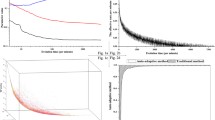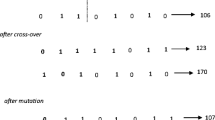Abstract
Recent studies in water resources planning and management show a gradual shift in the state of the art from numerous on-site structural stormwater Best Management Practice (BMP) designs to watershed-scale BMP design approaches that meet both target water quantity (peak flow) and quality (sediment reduction) criteria. Such regionally-strategic approaches are not only cost-effective but emphasize comprehensive, holistic watershed-scale management, an idea strongly promoted by the U.S. Environmental Protection Agency (US EPA) since the early 1990s. Implementing a watershed-scale design can prove difficult when decision-makers have differing and sometimes conflicting objectives. We present a methodology that integrates the semi-distributed watershed model Soil and Water Assessment Tool (SWAT) with an evolutionary algorithm, Species Conserving Genetic Algorithm (SCGA). In addition to identifying an optimal watershed-scale BMP design (e.g., type, size, location), SCGA simultaneously produces several near-optimal design alternatives using a user-specified distance metric. We demonstrate this decision-oriented framework on a watershed in southern Illinois. Results of this application yield several high-quality alternative designs appropriate for solving integrated watershed management problems.






Similar content being viewed by others
Abbreviations
- SWAT:
-
Soil and Water Assessment Tool
- BMP:
-
Best Management Practice
- US EPA:
-
U.S. Environmental Protection Service
- EA:
-
Evolutionary Algorithm
- SCGA:
-
Species Conserving GA
- EAGA:
-
Evolutionary Algorithm to Generate Alternatives
- HRU:
-
Hydrological Response Unit
- NRCS:
-
National Resources Conservation Service
- USDA:
-
U.S. Department of Agriculture
- CN:
-
Curve Number
- MOPSO:
-
Multi-Objective Particle Swarm Optimization
References
Arabi M, Govindaraju RS, Hantush MM (2006) Cost-effective allocation of watershed management practices using a genetic algorithm. Water Resour Res AGU 42:W10429. doi:10.1029/2006WR004931
Arnold JG, Fohrer R (2005) SWAT2000: current capabilities and research opportunities in applied watershed modeling. Hydrol Process 19(3):563–572
Arnold JG, Srinivasan R, Muttiah RS, Williams JR (1998) Large area hydrologic modeling and assessment. Part 1: model development. J Am Water Resour Assoc 34(1):73–89
ASAE (2003) Design, layout, construction and maintenance of terraces systems. ASABE, St Joseph, pp 49085–49659, 1950 Niles Road
Beasley D, Bull DR, Martin RR (1993) A sequential niche technique for multimodal function optimization. Evol Comput 1(2):101–125
Bracmort KS, Arabi M, Frankenberger JR, Engel BA, Arnold JG (2006) Modeling long term water quality impact of structural BMPs. Am Soc Agric Biol Eng 49(2):367–374
Brill ED, Flach JM, Hopkins LD, Ranjithan S (1990) MGA: A decision support system for complex, incompletely defined problems. IEEE Trans Syst Man Cybern 20:745–757
Chen L, Chang FJ (2007) Applying a real-coded multi-population genetic algorithm to multi-reservoir operation. Hydrol Process 21:688–698
Chen E, Mackay DS (2004) Effects of distribution-based parameter aggregation on a spatially distributed agricultural nonpoint source pollution model. J Hydrol 295(1–4):211–224
Costa e Silva M, Coelho LS, Lebenaztajn L (2012) Multiobjective biogeography-based optimization based on predator–prey approach. IEEE Trans Magn 48(2):951–954
Davidor Y (1991) A naturally occurring niche and species phenomenon: the model and first results. In: Belew RK, Booker LB (eds) Proc. of the Fourth Int. Conf. on Genetic Algorithms, San Mateo, CA, pp. 257–263
Della Cioppa A, De Stefano C, Marcelli A (2004) On the role of population size and niche radius in fitness sharing. IEEE Trans Evol Comput 8(6):580–592
Di Luzio M, Srinivasan R, Arnold JG, Neitsch SL (2002) ArcView interface for SWAT2000. Blackland Research and Extension Center, Texas Experiment Station and Grassland, Soil and Water Research Lab., USDA-ARS
Elliot A (1998) Model for preliminary catchment-scale planning of urban stormwater quality controls. J Environ Manag 52(3):273–288
Emerson CH, Welty C, Traver RG (2005) Watershed-scale evaluation of a system of storm water detention basins. J Hydrol Eng 10(3):237–242
Gill MK, Kaheil YH, Khalil A, McKee M, Bastidas L (2006) Multiobjective particle swarm optimization for parameter estimation in hydrology. Water Resour Res 43:W07417
Glover F (1989) Tabu search—Part I. ORSA J Comput 1(3):190–206
Goldberg DE, Richardson J (1987) Genetic algorithms with sharing for multimodal function optimization. In: Grefenstette JJ (ed) Proc of the Second Int Conf on Genetic Algorithms, Hilldale, NJ, 41–49
Gupta HV, Sorooshian S, Yapo PO (1999) Status of automatic calibration in hydrologic models: comparison with multilevel expert calibration. J Hydrol Eng 4(2):135–143
Gustafson S, Burke EK (2006) The speciating island model: an alternative parallel evolutionary algorithm. J Parallel Distrib Comput 66(8):1025–1036
Harrell LJ, Ranjithan SR (2003) Detention pond design and land use planning for watershed management. J Water Resour Plan Manag 129(2):98–106
Jha MK, Gassman PW, Secchi S, Gu RR, Arnold JG (2004) Effect of watershed subdivision on SWAT flow, sediment, and nutrient predictions. J Am Water Resour Assoc 40(3):811–825
Kaini P, Artita KS, Nicklow JW (2012) Optimizing structural best management practices using SWAT and genetic algorithm to improve water quality goals. Water Resour Manag 26(10):1827–1845
Li JP, Balazs ME, Parks GT, Clarkson PJ (2002) A species conserving genetic algorithm for multimodal function optimization. Evol Comput 10(3):207–234
Li JP, Balazs ME, Parks GT, Clarkson PJ (2003) Erratum: a species conserving genetic algorithm for multimodal function optimization. Evol Comput 11(1):107–109
Li JP, Balazs ME, Parks GT (2007) Engineering design optimization using species-conserving genetic algorithms. Eng Optim 39(2):147–161
Mahfoud SW (1995) Niching methods for genetic algorithms. IlliGAL Technical Report 95001. Illinois Genetic Algorithms Laboratory, Univ Illinois, Urbana
Mausbach MJ, Dedrick AR (2004) The length we go—Measuring environmental benefits of conservation practices. J Soil Water Conserv 59(5):96–103
Moriasi DN, Arnold JG, Van Liew MW, Binger RL, Harmel RD, Veith TL (2007) Model evaluation guide- lines for systematic quantification of accuracy in watershed simulations. Am Soc Agric Biol Eng 50(3):885–900
Muhlenbein H, Schomisch M, Born J (1991) The parallel genetic algorithm as function optimizer. Parallel Comput 17(6–7):619–632
Muleta MK, Nicklow JW, Bekele EG (2007) Sensitivity of a distributed watershed simulation model to spatial scale. J Hydrol Eng ASCE 12(2):163–172
Nash JE, Sutcliffe JV (1970) River flow forecasting through conceptual models Part I—a discussion of principles. J Hydrol 10:282–290
Neitsch SL, Arnold JG, Kiniry WJR, King KW (2002a) Soil and Water Assessment Tool, theoretical documentation version 2000. USDA-ARS, Temple
Neitsch SL, Arnold JG, Kiniry JR, Srinivasan R, Williams JR (2002b) SWAT: Soil and Water Assessment Tool, user’s manual. USDA-ARS, Temple
Perez-Pedini C, Limbrunner JF, Vogel RM (2005) Optimal locations of infiltration-based best management practices for stormwater management. J Water Resour Plan Manag 131(6):441–448
Simon D, Ergezer M, Du DW, Rarick R (2011) Markov models for biogeography-based optimization. IEEE Trans Syst Man Cybern B Cybern 41(1):299–306
Singh J, Knapp HV, Demissie M (2004) Hydrologic modeling of the Iroquois River watershed using HSPF and SWAT. ISWS CR 2004–08, Illinois State Water Survey, Champaign, Illinois, available at: nwww.sws.uiuc.edu/pubdoc/CR/ISWSCR2004-08.pdf
Tripathi MP, Raghuwanshi NS, Rao GP (2006) Effect of watershed subdivision on simulation of water balance components. Hydrol Process 20:1137–1156
US EPA (2003) National management measures to control nonpoint pollution from agriculture (http://www.epa.gov/nps/agmm/) Accessed on: 09/20/2008, EPA-841-B-03-004
US EPA (2004) Impact of best management practices of water quality of two small watersheds in Indiana: role of spatial scale. EPA/600/R-05/080
Veith TL, Wolfe ML, Heatwole CD (2003) Optimization procedure for cost effective BMP placement at a watershed scale. J Am Water Resour Assoc 39(6):1331–1343
Yeh CH, Labadie JW (1997) Multi-objective watershed level planning on storm water detention system. J Water Resour Plan Manag 123(6):336–343
Zechman EM, Ranjithan RS (2004) An evolutionary algorithm to generate alternatives (EAGA) for engineering optimization problems. Eng Optim 36:539–553
Zechman EM, Ranjithan RS (2007) Generating alternatives using evolutionary algorithms for water resources and environmental management problems. J Water Resour Plan Manag 133:156–165
Zhen X, Yu SC, Lin J (2004) Optimal location and sizing of stormwater basins at watershed scale. J Water Resour Plan Manag 130(4):339–347
Acknowledgments
This research was supported by the U.S. Department of the Interior, the U.S. Geological Survey, and the Board of Trustees of the University of Illinois under Grant No. 06HQGR0185. The first author is grateful to M Sears and J Brajkovich for their Linux/computer support.
Author information
Authors and Affiliations
Corresponding author
Rights and permissions
About this article
Cite this article
Artita, K.S., Kaini, P. & Nicklow, J.W. Examining the Possibilities: Generating Alternative Watershed-Scale BMP Designs with Evolutionary Algorithms. Water Resour Manage 27, 3849–3863 (2013). https://doi.org/10.1007/s11269-013-0375-3
Received:
Accepted:
Published:
Issue Date:
DOI: https://doi.org/10.1007/s11269-013-0375-3




